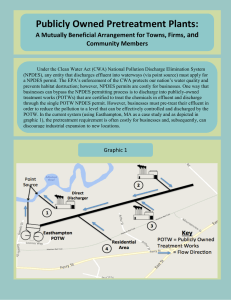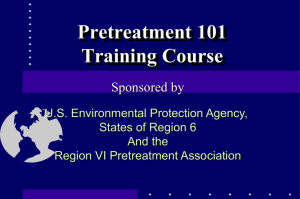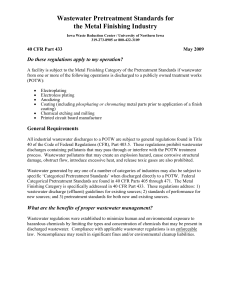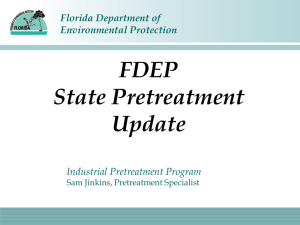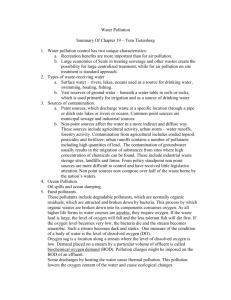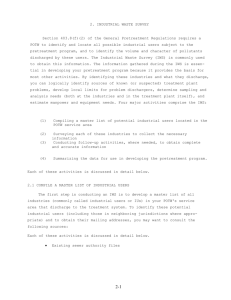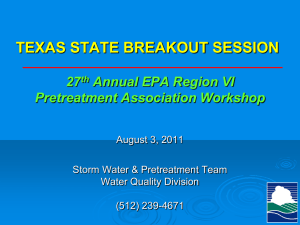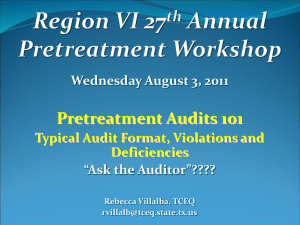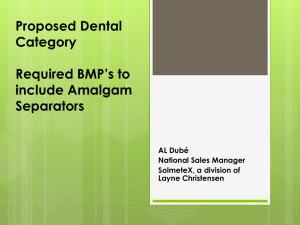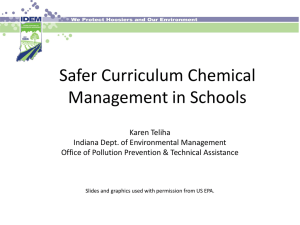epa-update-spring-2011-2
advertisement
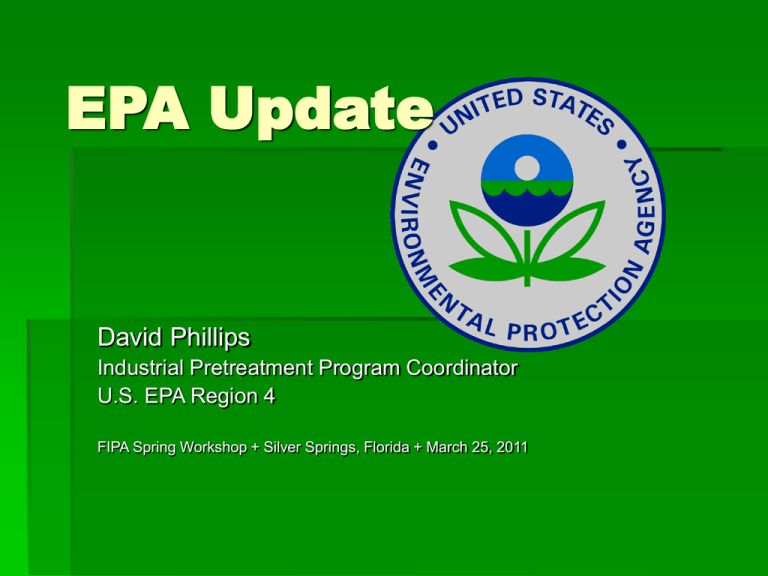
EPA Update David Phillips Industrial Pretreatment Program Coordinator U.S. EPA Region 4 FIPA Spring Workshop + Silver Springs, Florida + March 25, 2011 New Categorical Standards Being Considered Healthcare Industry Unused Pharmaceuticals Hospitals Long-term Care Facilities Hospices Clinics (school, prison, community) Doctor’s offices Veterinary Clinics and Hospitals New Categorical Standards Being Considered Healthcare Industry Unused Pharmaceuticals Hospitals Long-term Care Facilities Hospices Clinics (school, prison, community) Doctor’s offices Veterinary Clinics and Hospitals New Categorical Standards Being Considered Healthcare Industry Unused Pharmaceuticals “Best practices” (i.e., BMPs) being developed for Hospitals and Long Term Care Facilities Details to be released with Final 2010 ELG Plan http://www.smarxtdisposal.net http://www.disposemymeds.org New Categorical Standards Being Considered Airport Deicing Operations EPA proposed standards in 2009 High Ammonia wastewaters Dental Amalgam Voluntary BMP Program Underway (ADA) EPA-proposed Standards expected 2011 EPA final Standards expected 2012 New Categorical Standards Being Considered Dental Amalgam ADA-funded study indicated 50% of mercury entering POTWs can originate from dental. Well-maintained amalgam separators capture/recycle 95-99% of dental mercury. Use reduces free mercury in influent and biosolids (reports of 30-50% biosolids reduction). Use may have limited impact on reducing mercury elevated in POTW effluent. Amalgam Separators New Categorical Standards Being Considered Dental Amalgam Is anyone mandating use/maintenance of amalgam separators? (2008) 11 States and 20 local jurisdictions. Can I use local limits? (Yes) MWRA (Massachusetts, 350 MGD, 250+ SIU) Local limit established is 1 ppb (mg/L) Mercury sources: dentists 18%, industry 3%, Other 84% Reduction from medical sources in 5 years: 91% Annual penalties collected: ~$400k-100k Revisions to Existing Standards Being Considered OCPSF/Inorganics/Pharma Mfg – Parts 414/415/439 Chlorine and Chlorinated Hydrocarbons (CCH) Manufacturing Dioxins…forming from manufacture of : ethylene dichloride (EDC) vinyl chloride monomer (VCM) polyvinyl chloride (PVC) Revisions to Existing Standards Being Considered OCPSF/Inorganics/Pharma Mfg – Parts 414/415/439 Chlorine and Chlorinated Hydrocarbons (CCH) Manufacturing Mercury…increases due to new air pollution controls in mercury-cell process to manufacture : Chlorine Caustics Revisions to Existing Standards Being Considered Steam Electric Power – Part 423 EPA-proposed rule expected 2012 EPA-final rule expected 2014 www.epa.gov/guide/steam Pending Guidance IU Permitting Guidance Manual Updates 1989 guidance Will be released with a Webcast www.epa.gov/npdes/pretreatment Publications (right-side box) Pending Guidance Introduction to the National Pretreatment Program Updates 1999 manual Will be released with a Webcast www.epa.gov/npdes/pretreatment Publications (right-side box) Guidance in Development Guidance for POTW Pretreatment Program Development Updates 1983 guidance Procedures for Reviewing POTW Pretreatment Program Submissions Updates 1983 guidance Webcasts www.epa.gov/npdes/pretreatment Trainings and Meetings (right-side box) Register for upcoming casts and/or scroll to Pretreatment listings Posted: Compliance Monitoring 101 Compliance Inspections 101 Industrial Waste Surveys 101 Other topics POTW Pretreatment Programs in SNC Region 4 closely reviewing State reports Elevated response from EPA where: POTW’s SNC continues despite State actions POTW’s SNC unresolved for two quarters or more State requests EPA action FOG Programs and Pretreatment: Regulatory Basis FOG Programs and Pretreatment: Regulatory Basis What is an Industrial User? 40 CFR 403.3(j) • An industrial user is a source of indirect discharge. What is an Indirect Discharge? 40 CFR 403.3(i) • Introduction of pollutants into a POTW from any nondomestic source regulated under section 307(b), (c), (d) of the Clean Water Act. All non-domestic sources regulated by Pretreatment Standards require a control mechanism. 40 CFR 403.8(f) FOG Programs and Pretreatment: Regulatory Basis What is a Pretreatment Standard? 40 CFR 403.3(l) • Any categorical standards applicable to IUs • Any prohibitions in 40 CFR 403.5 40 CFR 403.5(d) • Local limits FOG Programs and Pretreatment: Regulatory Basis Specific Prohibitions - 403.5(b) The following pollutants shall not be introduced into a POTW: 403.5(b)(3) • Solid or viscous pollutants in amounts which will cause obstruction to the flow in the POTW resulting in Interference. 403.5(b)(4) • Any pollutant at a flow rate or concentration that will cause Interference with the POTW. FOG Programs and Pretreatment: Regulatory Basis What is a POTW? 40 CFR 403.3(q) • A treatment works owned by a municipality. This definition includes any devices or systems used in the storage, treatment, recycling, and reclamation of municipal sewage or liquid industrial wastes. It also includes sewers, pipes, and other conveyances that convey wastewater to a municipal treatment plant. What is Interference? 40 CFR 403.3(k) • A discharge, either alone or in combination with discharges from other sources, which both: (1) Inhibits or disrupts the POTW (see above); it’s treatment or operations, or sludge management (2) Causes a violation of any POTW permit requirement FOG Programs and Pretreatment: Regulatory Basis POTW permit requirements: …shall at all times properly operate and maintain… …shall implement approved pretreatment program and Part 403… The receiving sewer serves a commercial fast-food area. Is the source of this pollutant an industrial user? Can this pollutant cause Interference with the POTW, and therefore a violation of Pretreatment Standards? Do the industrial users that supply this pollutant require a control mechanism by the POTW Pretreatment Program? FOG Programs and Pretreatment: Regulatory Basis What about residential sources? They are domestic sources… Control also necessary to meet common goals: Meet proper O&M condition of NPDES permit Prevent sewer overflow violations Authorities for controlling domestic FOG sources are local Questions Phillips.David@epa.gov (404) 562-9773
